Securing a jet ski to a floating dock is an essential skill for watercraft owners, ensuring the safety and longevity of their valuable equipment. Understanding how to secure jet ski to floating dock not only protects the jet ski from potential damages caused by improper docking but also safeguards individuals from accidents.
This section covers the critical aspects of docking, highlighting the importance of correctly securing jet skis for both safety and protection. It provides a comprehensive overview of the different methods and techniques available for secure attachment to floating docks, offering insights into the best practices that jet ski owners can adopt.
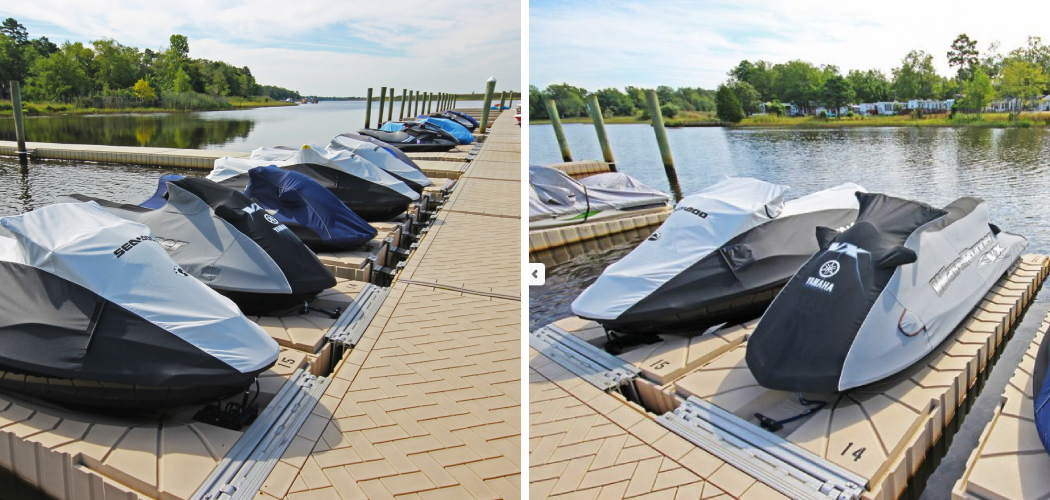
This foundational knowledge is a prerequisite for effectively maintaining and enjoying watercraft in various marine environments.
Assessing Dock and Jet Ski Compatibility
When it comes to securing jet skis to floating docks, one of the first steps is to assess the compatibility between the dock and the jet ski. This assessment involves several key aspects:
A. Understanding Dock Design
The design and structure of the floating dock play a crucial role in determining how well it can accommodate and secure a jet ski. Floating docks come in various materials, sizes, and buoyancy capabilities, designed to cater to different watercraft types and sizes.
Familiarizing yourself with the dock’s design, including its load capacity, the material it’s made from (wood, metal, or plastic), and any features like built-in cleats or mooring points, is essential. This knowledge will help determine if additional modifications or accessories are needed to secure your jet ski properly.
B. Evaluating Jet Ski Dimensions
The size and weight of your jet ski are just as important to consider. Knowing your jet ski’s dimensions helps ensure it fits well within the dock’s space and doesn’t exceed the dock’s weight capacity. Measure the length, width, and weight of your jet ski and compare these against the specifications of your floating dock to assess compatibility.
This step is vital in preventing potential docking issues or damages to both your dock and jet ski.
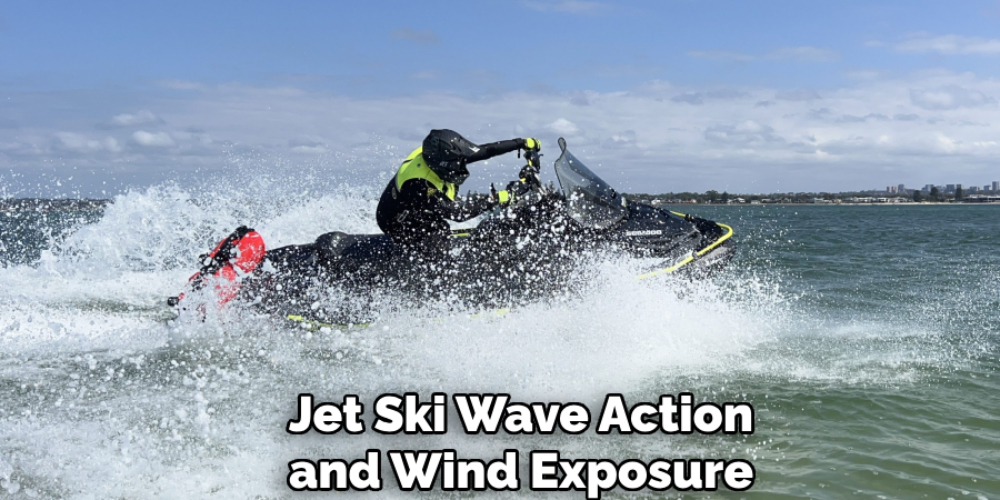
C. Considering Environmental Factors
Environmental conditions such as water depth, wave action, and wind exposure can greatly impact the stability and suitability of the docking area. These factors are crucial for determining the best docking practices for your location. For example, areas with high wave action might require additional mooring lines or specific types of dock configurations to ensure the jet ski remains secure.
Similarly, consideration of wind exposure and water depth will inform whether additional stabilizing measures or dock modifications are necessary to accommodate your jet ski safely.
How to Secure Jet Ski to Floating Dock: Installing Docking Hardware
Installing the right docking hardware is fundamental in ensuring that a jet ski is securely attached to a floating dock. This section dives into the specifics of selecting and installing dock cleats, which are the primary mooring points for securing jet ski lines.
A. Choosing Suitable Dock Cleats
Selecting the right dock cleats involves considering their durability, material, and capacity to handle the weight and tension exerted by a jet ski. Heavy-duty cleats made from materials like stainless steel or marine-grade aluminum are preferred for their resistance to corrosion and ability to withstand significant force.
The cleat size should be compatible with the diameter of the docking lines used, ensuring a secure fit that can handle the jet ski’s movements caused by water dynamics.

B. Mounting Cleats Securely
Once the appropriate cleats have been selected, the focus shifts to mounting them securely to the dock structure. This process requires the use of proper hardware, such as stainless steel screws or bolts, that are suitable for the dock’s material.
Using a drill and ensuring that the cleats are anchored into the dock’s framework (not just the surface material) will provide the necessary stability. The installation process must take into account the dock’s construction, with attention paid to avoiding any damage that might compromise its integrity.
C. Positioning Cleats Strategically
The effectiveness of dock cleats depends not only on their quality and installation but also on their strategic placement along the dock. Cleats should be positioned to facilitate easy access for securing and releasing jet ski lines, considering the jet ski’s size and the direction of predominant winds and currents.
Placing cleats at both the front and rear ends of the docking space allows for a more balanced distribution of tension, reducing strain on any single point. Additionally, the positioning should accommodate the use of bow and stern lines to prevent lateral movement, ensuring that the jet ski remains stable and well-secured to the dock.
By carefully choosing, mounting, and positioning dock cleats, jet ski owners can significantly enhance the safety and reliability of their docking arrangements, providing peace of mind that their watercraft is well-protected at the dock.
How to Secure Jet Ski to Floating Dock: Securing Jet Ski Lines
Securing your jet ski to the floating dock using dock lines is essential in protecting your investment from unanticipated movement caused by waves, wind, or passing watercraft. This process requires careful consideration of the type of dock lines used, the method of attachment, and ongoing adjustments to the line tension for optimal security and stability.
A. Using Dock Lines
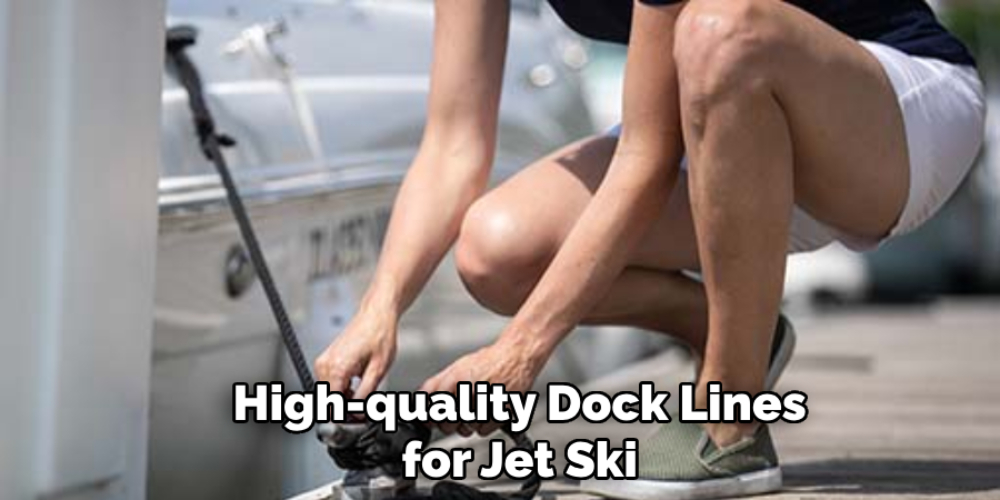
Selecting high-quality dock lines or ropes is vital for the safe mooring of your jet ski. These lines must possess sufficient strength and durability to withstand the marine environment, including UV rays, saltwater, and abrasion resistance. Typically, dock lines made from nylon are preferred for their elasticity, which allows for slight stretching under load, absorbing the impact from waves and reducing stress on the jet ski and dock cleats.
The thickness and length of the dock lines should also be suitable for the size and weight of the jet ski, ensuring they can bear the load without the risk of snapping or becoming overstretched.
B. Attaching Lines to Cleats
The method of tying dock lines to cleats is paramount for a secure mooring. Knots such as the cleat hitch or bowline are recommended for their reliability and ease of untying. A cleat hitch, for example, is accomplished by wrapping the line around the base of the cleat, then executing a figure-eight pattern around the cleat’s arms and finishing with a locking loop.
This knot provides a firm hold yet can be quickly released when necessary. The lines must be tied snugly to the cleats on both the jet ski and the dock, minimizing slack that could lead to excessive movement.
C. Adjusting Line Tension
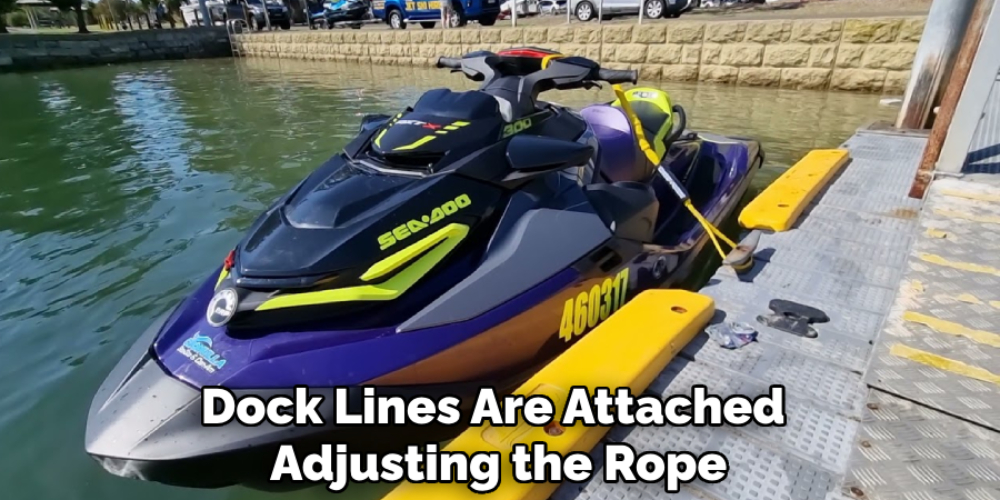
Once dock lines are attached, adjusting the tension is crucial to maintain the proper positioning and stability of the jet ski relative to the dock. Lines should be tight enough to prevent the jet ski from moving too much yet not so taut that they strain the cleats or the jet ski’s attachment points.
Regular checks and adjustments are necessary, especially in response to changing weather conditions and water levels or after significant impact from waves or other forces. This fine-tuning ensures that the jet ski remains securely attached and positioned within its allotted space on the dock, reducing the risk of damage or detachment.
By meticulously selecting the right dock lines, correctly attaching them to cleats with appropriate knots, and regularly adjusting line tension, jet ski owners can ensure their watercraft remains safe and secure while moored to floating docks. This careful attention to detail in securing jet ski lines plays a critical role in the overall protection and longevity of the jet ski.
Utilizing Docking Accessories
Enhancing the safety and durability of your jet ski docking arrangement involves incorporating specific docking accessories. These accessories not only offer an additional layer of protection but also ease the docking process, ensuring your jet ski remains secure and undamaged over time.
A. Dock Fenders or Bumpers
Installing dock fenders or bumpers along the dock edge is a proactive step to protect both the jet ski and the dock from impact damage. These cushioning accessories absorb shock and minimize abrasion, which is critically important during high winds or strong currents that could cause the jet ski to collide against the dock.
Available in various sizes and materials, selecting the right dock fenders ensures that the impact is significantly softened, safeguarding the structural integrity of both the jet ski and the docking area.
B. Mooring Whips
Mooring whips or poles are a preventive solution, offering additional support and stability for jet skis in changing water conditions. By applying tension, these flexible rods maintain a safe distance between the jet ski and the dock, reducing the impact risk during fluctuating tide levels or in the wake of passing vessels.
The use of mooring whips is especially beneficial in exposed docking locations where environmental factors could provoke excessive movement of moored watercraft.
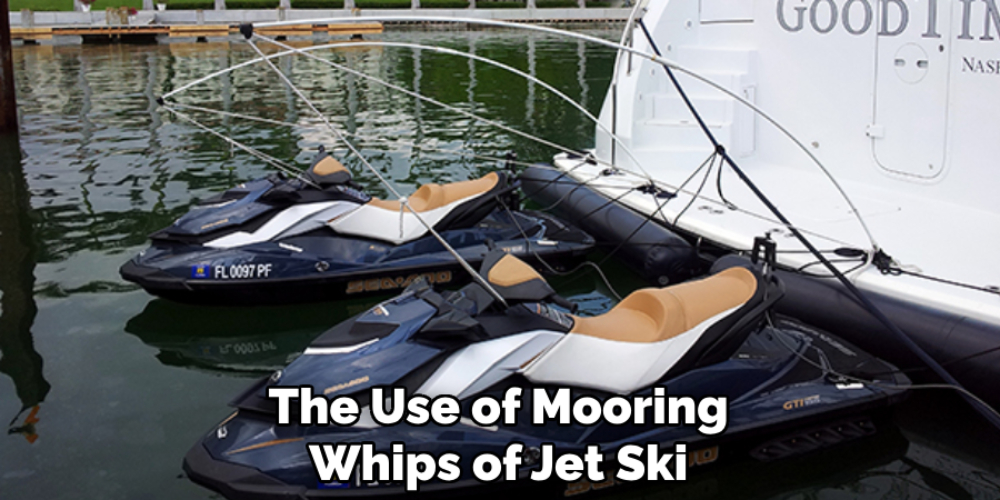
C. Floatation Devices
Attaching floatation devices or buoyant elements to jet ski lines is critical in preventing submersion or damage in rough water conditions. These devices ensure that even if a line fails or becomes detached, the end attached to the jet ski remains afloat, making it easier to retrieve and re-secure. Additionally, in the event of significant water level changes, these flotation aids help maintain optimal line tension, preventing the jet ski from drifting underneath the dock or becoming overly strained by the mooring setup.
By thoughtfully incorporating docking accessories such as dock fenders or bumpers, mooring whips, and flotation devices into your mooring strategy, you can significantly enhance your jet ski’s safety, stability, and longevity.
These elements contribute to the physical protection of your watercraft and docking infrastructure and provide peace of mind, knowing that your investment is well-shielded against various maritime challenges.
Regular Inspection and Maintenance
To ensure the durability and safety of your jet ski docking arrangement, a regimented inspection and maintenance schedule is crucial. This process not only identifies potential issues before they escalate but also guarantees that all components of the mooring remain effective and reliable.
A. Routine Checkups
Regular inspections of dock cleats, lines, and hardware are paramount in preventing small, fixable issues from becoming significant problems. Look for signs of wear, corrosion, or damage, especially on parts that are constantly exposed to saltwater and sunlight
It is advisable to perform these checkups at least at the start and end of the boating season and following severe weather events. Replace any worn or corroded parts immediately to maintain the integrity of your docking setup.
B. Performing Maintenance
The longevity of your jet ski and docking equipment heavily depends on timely maintenance. After a thorough inspection, perform necessary repairs or replacements of docking hardware or accessories.
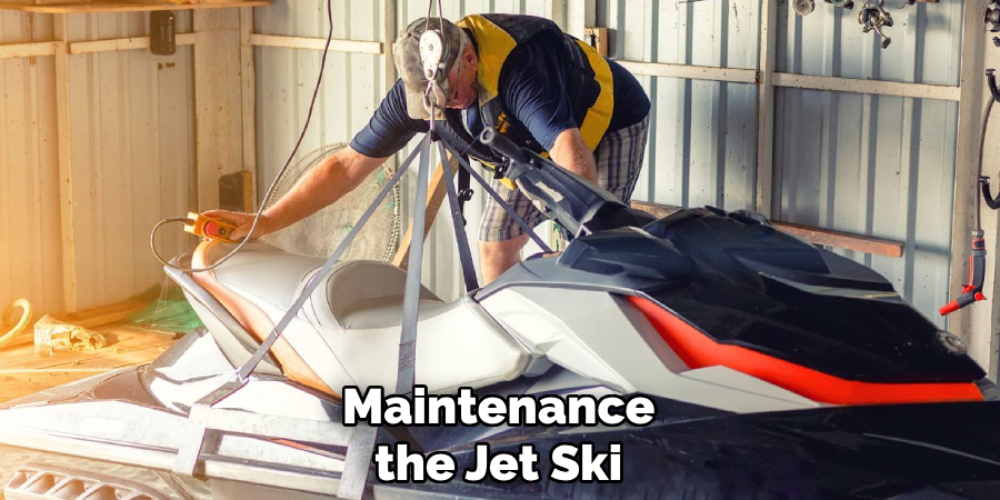
This includes replacing frayed lines, tightening loose cleats, and refurbishing or replacing damaged fenders or bumpers. Equally important is using marine-grade materials for any repairs to ensure compatibility with the aquatic environment and provide long-lasting resilience against the elements.
C. Adjusting as Needed
Regularly monitoring your docking setup allows you to make immediate adjustments to address changing conditions or usage patterns. This could involve repositioning mooring whips based on seasonal water levels, adjusting line tension in anticipation of a storm, or relocating dock fenders to better protect against the current movement patterns of your jet ski.
Proactive adjustments ensure optimal protection and stability of your jet ski throughout different seasons and under varying environmental conditions.
By dedicating time to routine inspections, performing necessary maintenance, and making proactive adjustments, you ensure not only the safety of your jet ski but also the longevity and reliability of your docking arrangement. This regular attention to detail is fundamental in avoiding unforeseen incidents and maintaining a secure moorage for your watercraft.
Safety Precautions and Considerations
Safety is paramount when it comes to enjoying and using jet skis and their docking areas. Implementing key safety measures can significantly reduce the risk of accidents and ensure a pleasurable experience for everyone involved.
A. Clear Pathways
One of the foundational aspects of dock safety involves maintaining clear pathways around the jet ski and dock area. Trip hazards can easily lead to injuries, particularly in wet conditions where surfaces may become slippery.
Regularly inspect the dock and its surroundings to remove any obstacles, ensuring that access to and from the jet ski is unimpeded. Adequate lighting should also be considered to improve visibility during dawn, dusk, or nighttime hours, further reducing the likelihood of trips or falls.
B. Secure Storage
The importance of securely storing personal belongings, equipment, and especially fuel containers cannot be overstressed. Loose items on the dock can create trip hazards and pose a risk of damaging the jet ski or dock.
Secure storage options such as lockable dock boxes ensure that equipment is safe and organized while also safeguarding against environmental damage. Proper storage of fuel containers minimizes the risk of spills into the water, helping to prevent pollution and possible fire hazards.
C. Weather Awareness
Understanding and respecting the power of nature is crucial for jet ski owners. Monitoring weather forecasts allows for proactive measures to be taken in securing jet skis and other gear in anticipation of inclement weather or high winds.
This could involve double-checking mooring lines, moving jet skis to more protected areas, or using additional docking accessories to mitigate the impact of storms. Awareness and preparation can significantly reduce the risk of damage to both the jet ski and the docking infrastructure, ensuring that your watercraft is ready for enjoyment as soon as favorable conditions return.

Frequently Asked Questions
Q: How Often Should I Replace My Jet Ski Mooring Lines?
A: Mooring lines should be inspected regularly and replaced every 2-3 years, or sooner if signs of significant wear, such as fraying or stiffness, are observed. Using marine-grade lines ensures durability and resistance to the harsh marine environment.
Q: Can I Use Regular Dock Fenders for My Jet Ski?
A: Yes, regular dock fenders can be used for jet skis, but specialized jet ski fenders are designed to fit the contours of jet skis more closely, offering better protection. Consider the specific needs of your jet ski and docking space when choosing fenders.
Q: What Is the Best Way to Secure a Jet Ski During a Storm?
A: To secure a jet ski during a storm, ensure it is moored in a protected area with extra lines and fenders if available. Increase the mooring line’s length to allow for higher water levels, and consider using anchors if docking in a less protected area. Removing the jet ski from the water and storing it on land in a secure location is the safest option when possible.
Q: How Can I Prevent My Jet Ski from Being Stolen While Docked?
A: Use a combination of physical and visual theft deterrents. Lock your jet ski to the dock with a high-quality marine lock and chain. Consider installing motion-activated lights or a security camera aimed at the docking area. Additionally, removing the ignition safety clip when not in use makes the jet ski inoperable.
Q: Do I Need to Adjust My Docking Setup for Different Seasons?
A: Yes, seasonal adjustments to your docking setup may be necessary, especially if you experience significant changes in water levels, weather conditions, or if the jet ski is not being used for extended periods. Adjust the positioning of mooring whips, fenders, and the tightness of mooring lines accordingly. Winterization and additional security measures should be considered for off-season storage.
Conclusion
In this guide, we’ve explored comprehensive methods and techniques for how to secure jet ski to floating dock. From utilizing dock fenders, mooring whips, and flotation devices to conducting regular inspections and maintenance, we’ve covered the essentials that ensure your watercraft’s safety, stability, and protection.
Proper docking procedures are about prolonging your jet ski’s life and ensuring the safety of all who use and enjoy it. These practices are crucial for mitigating potential hazards and ensuring that your jet skiing adventures remain enjoyable and free from preventable issues.
By emphasizing the importance of these techniques, we aim to enhance your jet skiing experience, making it safer and more enjoyable for everyone involved. Whether you’re new to the world of jet skiing or a seasoned enthusiast, understanding and applying these principles will serve to protect your investment and ensure countless hours of fun on the water.
We wish you safe and enjoyable jet skiing adventures filled with the thrill of the ride and the assurance of well-secured watercraft.
About
Safety Fic is a distinguished figure in the world of Diy design, with a decade of expertise creating innovative and sustainable Diy solutions. His professional focus lies in merging traditional craftsmanship with modern manufacturing techniques, fostering designs that are both practical and environmentally conscious. As the author of diy, Safety Fic delves into the art and science of Safety Fic-making, inspiring artisans and industry professionals alike.
Education RMIT University
(Melbourne, Australia) Associate Degree in Design (Safety Fic) Focus on sustainable design, industry-driven projects, and practical craftsmanship. Gained hands-on experience with traditional and digital manufacturing tools, such as CAD and CNC software.
Nottingham Trent University
(United Kingdom) Bachelor’s in diyfastly.com and Product Design (Honors) Specialized in product design with a focus on blending creativity with production techniques. Participated in industry projects, working with companies like John Lewis and Vitsoe to gain real-world insights.
Publications and Impact
In diy, Safety Fic his insights on indoor design processes, materials, and strategies for efficient production. His writing bridges the gap between artisan knowledge and modern industry needs, making it a must-read for both budding designers and seasoned professionals.
